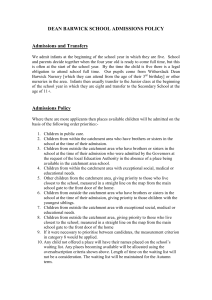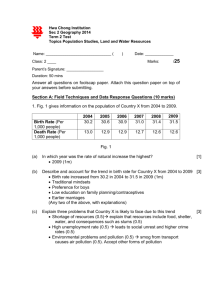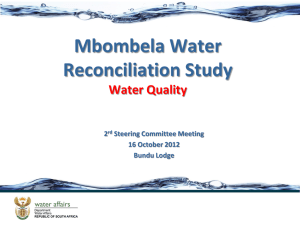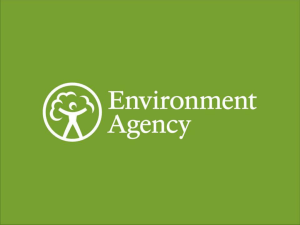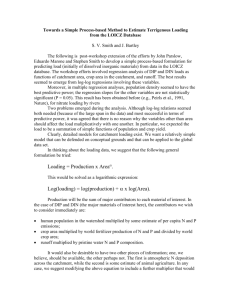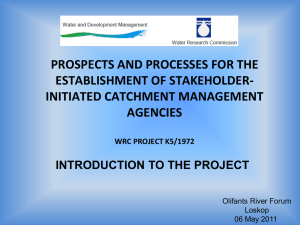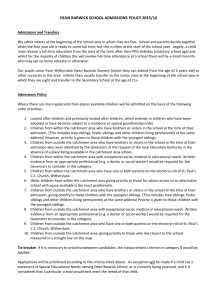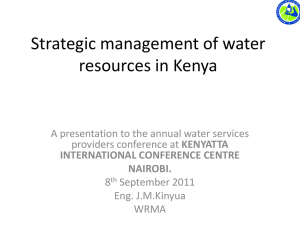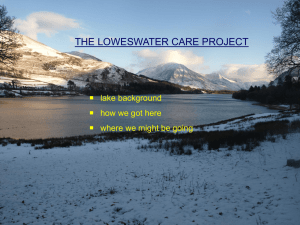Source
advertisement
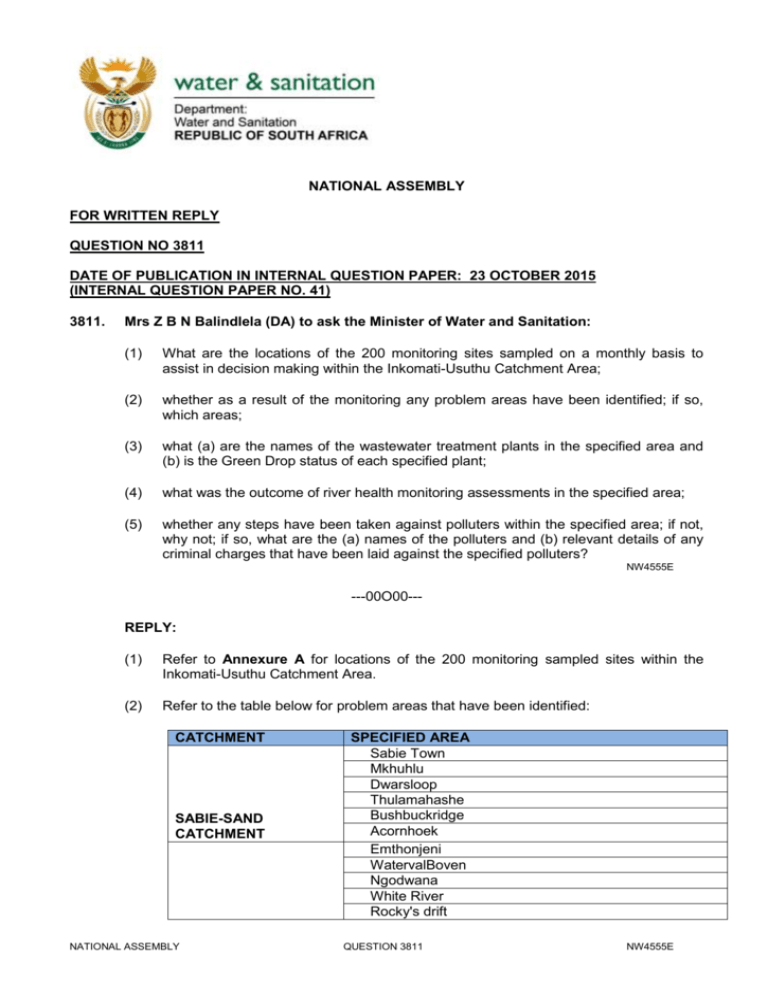
NATIONAL ASSEMBLY FOR WRITTEN REPLY QUESTION NO 3811 DATE OF PUBLICATION IN INTERNAL QUESTION PAPER: 23 OCTOBER 2015 (INTERNAL QUESTION PAPER NO. 41) 3811. Mrs Z B N Balindlela (DA) to ask the Minister of Water and Sanitation: (1) What are the locations of the 200 monitoring sites sampled on a monthly basis to assist in decision making within the Inkomati-Usuthu Catchment Area; (2) whether as a result of the monitoring any problem areas have been identified; if so, which areas; (3) what (a) are the names of the wastewater treatment plants in the specified area and (b) is the Green Drop status of each specified plant; (4) what was the outcome of river health monitoring assessments in the specified area; (5) whether any steps have been taken against polluters within the specified area; if not, why not; if so, what are the (a) names of the polluters and (b) relevant details of any criminal charges that have been laid against the specified polluters? NW4555E ---00O00--REPLY: (1) Refer to Annexure A for locations of the 200 monitoring sampled sites within the Inkomati-Usuthu Catchment Area. (2) Refer to the table below for problem areas that have been identified: CATCHMENT SABIE-SAND CATCHMENT NATIONAL ASSEMBLY SPECIFIED AREA Sabie Town Mkhuhlu Dwarsloop Thulamahashe Bushbuckridge Acornhoek Emthonjeni WatervalBoven Ngodwana White River Rocky's drift QUESTION 3811 NW4555E CROCODILE CATCHMENT RIVER UPPER CATCHMENT KOMATI LOWER CATCHMENT KOMATI USUTHU CATCHMENT (3) Kabokweni Kanyamazane Barberton Louieville Malelane Hectorspruit Komatipoort Seepage from Union Colliery Tributary of boesmanspruit at Tselentis Colliery Downstream of Tselentis Discard Dumps Coastal fuel @ Witkrans Seepage Carolina sewage Discharge point Elukwatini Driekoppies Tonga Hospital WWTW Tonga Ponds Ka-Maqhekeza Piet Retief Heyshope Dam (Downstream of Kangra mine) Amsterdam Assegai Refer to the table below for the names of the wastewater treatment plants in the specified area: Requesting the Honorable Member to note that the report of the Blue and Green Drop reports, has been submitted to Cabinet for approval in line with the exercise of executive authority in terms of section 85 of the Constitution hence the information cannot be provided at this point. CATCHMENT SABIE-SAND CATCHMENT NAME OF THE WWTW PLANTS Sabie WWTW Hazyview WWTW Mkhuhlu WWTW Dwarsloop Thulamahashe CROCODILE Emthonjeni sewage RIVER WatervalBoven sewage CATCHMENT (Sappi Ngodwana) Bambi on Elands Rriver White River WWTW Rocky's drift sewage Kabokweni WWTW Kanyamazane WWTW Barberton WWTW Louieville WWTW Final Discharge Mhlatiplaas WWTW final exit Mhlatikop WWTW Hectorspruit WWTW Komatipoort WWTW UPPER KOMATI Carolina WWTW CATCHMENT Elukwatini sewage Pump Station U/S of Elukwatini Pump Station ElukwatiniWWTW LOWER KOMATI Shongwe Hospital WWTW CATCHMENT Tonga Hospital WWTW Tonga Ponds Ka-Maqhekeza Plaza sewage package plants USUTHU Mkhondo WWTW NATIONAL ASSEMBLY QUESTION 3811 NW4555E CATCHMENT (4) Amsterdam WWTW The selection of monitoring sites for river health is completely different from chemical monitoring program. While the selection of monitoring sites for chemical monitoring program is activity based and seeks to establish the impact of land-based activities on the quality of water resources, the selection of monitoring sites for river health purposes looks at the reference conditions that best mimic the natural conditions of the river before development took place. The monitoring points for these respective monitoring programs are therefore far apart from each other in most instances and although it is possible to attribute the health of the river to the quality of the resource, it is not always accurate since it is not activity-based. Hence the number of monitoring sites for the River Health programme are fewer compared to those for chemical monitoring. The eco-status of the various catchment within the Inkomati-Usuthu Water Management Area are summarised below per catchment. Sabie Catchment – 15 of 20 sites were monitored along the length of the Sabie River (mainstream) from source till it enters the Kruger National Park was recorded to be at category B and even A in some places which is almost pristine. The head-waters of the Sabie River showed degraded eco-status and improved as the river continues downstream, contrary to the norm where the head-waters are more pristine and tend to deteriorate as the river progresses downstream. A detailed study of the upper reaches of the catchment revealed that the impact on the eco-status in the headwaters emanates from the poor maintenance of the road networks in the forestry plantations causing high sedimentation and increased turbidity. The moderately impacted to near pristine eco-status is attributed to the high flow of water in this river which provides adequate dilution for partially treated waste water discharged into the river. However, in areas where wastewater treatment works discharge partially treated waste, there has also been impact associated with the low levels of dissolved oxygen that results from the high organic loads that utilize oxygen to be broken down. This phenomenon is shown by the high prevalence of air breathing taxa (micro-organisms) recorded and conversely low prevalence of those taxa that get dissolved oxygen from water. These taxa were negatively affected by low levels of dissolved oxygen which occurs as a result of high organic loads found in partially treated domestic waste water. The Sabie River Eco-Status study was conducted in 2012/13. Crocodile Catchment – 15 of 18 sites were monitored along the length of the Crocodile River (main stem) from source till it enters Mozambique was recorded to be at category C and with 3 sites at category B/C. The level of development in this catchment is extremely high and composed of industry, mining, irrigated agriculture and wastewater treatment works. Two of the tree sites that are rated at category B/C are just upstream of Nelspruit. From Nelspruit down towards the border of Mozambique, the eco-status remains at category C. This is the stretch that contains the highest number of wastewater treatment works in this catchment. The Crocodile River Eco-Status study was conducted in 2013/14. Komati Catchment – 23 of 31 sites were monitored along the length of the Komati River (mainstream) from source till it enters Mozambique was recorded to be at category C and with 5 sites recording B category and 3 sites at category D. The level of degradation in this catchment is higher due to mining development but not necessarily wastewater treatment works. There are actually fewer wastewater treatment works in this catchment than in both the Sabie and the Crocodile Catchments. The Komati River Eco-Status study was conducted in 2014/15. Usuthu Catchment – Assessment currently underway and will be completed in the first quarter of 2016/17 financial year. NATIONAL ASSEMBLY QUESTION 3811 NW4555E (5) Yes, steps have been taken against those activities that negatively impact on the water resources including issuing of notices and directives as well as opening of criminal cases and the details of the latter are presented in the table below: Name of the Polluter (a) Case Number Maviljan Ponds (Bushbuckridge Case 127/08/2014 Municipality) Thulamahashe WWTW (Bushbuckridge Local Municipality) Carolina WWTW (Chief Luthuli Local Municipality) Case 89/02/2014 Albert Case 57/09/2015 Hillsview Pump Station Case 35/07/2014 Twin City Hazyview (Mbombela Local Municipality) Case 112/02/2014 TTC manhole (ThabaChweu Local Case 11/05/2014 Municipality) Reasons for such actions Continuous discharge of partially treated sewage into a water resource. Continuous discharge of partially treated sewage into a water resource Continuous discharge of partially treated sewage into a water resource Continuous overflow of raw sewage into the water resource. Continuous overflow of raw sewage into the water resource Continuous overflow of raw sewage into the water resource ---00O00--- NATIONAL ASSEMBLY QUESTION 3811 NW4555E
